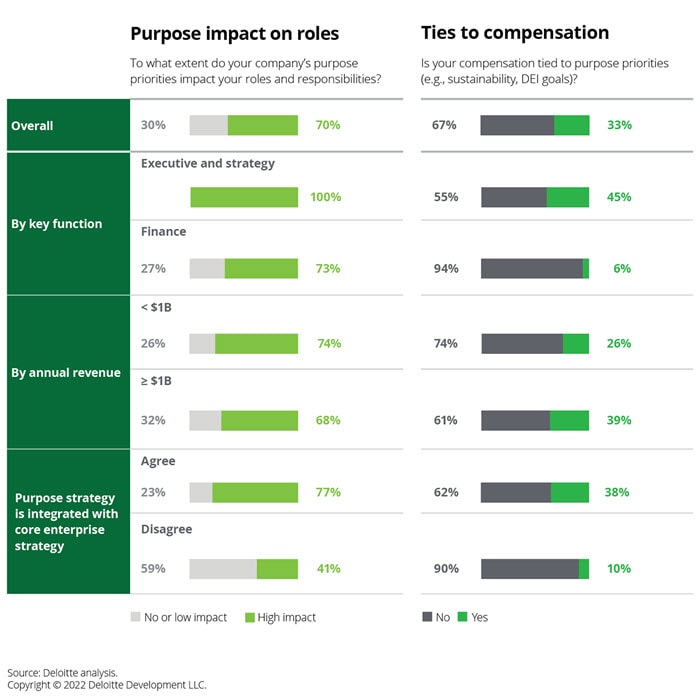C-suite insights: How purpose delivers value has been saved

Perspectives
C-suite insights: How purpose delivers value
The power of an authentic purpose across functions and the enterprise
While corporate responsibility, advocacy, and sustainability have been priorities for many companies for decades, they have often been managed in silos and peripherally to core business activities. Today, stakeholders expect companies to drive consistent impact through all aspects of their operations. In response, we are seeing more and more organizations reevaluating their purpose—the North Star that drives strategy and impact in the eyes of stakeholders.
Purpose: More than a tagline
Companies are increasingly being called upon by the public, employees, policymakers, investors, and other stakeholders to play a key role in addressing societal issues. A company’s purpose—its “why” in the eyes of its stakeholders—is the best framework to keep focused on long-term value and to navigate complex risks. It makes the company more valuable, focused, and resilient.
Stakeholder expectations are changing … and companies have to change with them. Having a clear purpose helps our business leaders to make decisions that, candidly, may go against traditional bottom-line thinking but help companies authentically commit to their purpose work.”
— Fran Katsoudas, Chief People, Policy & Purpose Officer at Cisco
But while there is a strong desire among companies of all types and sizes across industries to prioritize and integrate purpose, implementation remains a challenge—one with potential consequences: business leaders are facing risks associated with inconsistency of action and perceived purpose-washing.
In 2021, Deloitte surveyed 212 C-suite leaders from different functions and industries to understand the extent to which purpose is a priority for their role and respective organization, as well as key challenges and opportunities they face.
Key insights from the research include:
- Strategy: While 79% of surveyed C-suite leaders said their company has a clear and defined purpose strategy that is integrated with core business strategy, 22% in this group indicated that their company does not make it a priority to collect and report on purpose-related data, suggesting that purpose is not as well integrated as they believe.
- C-suite roles: Each member of the C-suite has an important role to play in defining and implementing purpose. The Chief Executive Officer’s role as champion is most critical to success, and the emerging role of the Chief Purpose or Sustainability Officer can enhance outcomes by providing shared infrastructure, subject-matter expertise, and function-specific guidance to drive accountability.
- Governance and collaboration: Formal and informal collaboration across the C-suite should be strengthened to effectively implement enterprisewide purpose. Collaboration with purpose or sustainability functions is especially low, indicating that the 44% of surveyed companies with C-suite leaders in these functions could be leaving value on the table. Formal governance at the board and executive levels, such as committees focused on purpose, enhance collaboration and enterprisewide implementation.
- Value creation: C-suite leaders viewed talent impacts as the greatest driver of value by far, with 79% agreeing that purpose supports talent recruitment, engagement, and retention. Only 17% agreed that purpose enhances access to capital, despite growing investor expectations related to ESG, signaling that companies may not recognize that a clear purpose can help them identify and manage the most material ESG issues for their business.
- Accountability: Although most surveyed C-suite leaders (70%) indicated that their role is highly impacted by their company’s purpose priorities, only a third said that their compensation is tied to their performance against those priorities. This link to executive compensation should be stronger to drive accountability.

So, how can business leaders authentically define and implement purpose?
Hear from five C-suite leaders about how they are approaching purpose as a driver of sustainable, long-term value and positive impact on society:
- Fran Katsoudas, Chief People, Policy & Purpose Officer at Cisco
- Chris Kuehn, Chief Financial Officer at Trane Technologies
- Leena Nair, Global Chief Executive Officer at Chanel
- Jim Swanson, Chief Information Officer at Johnson & Johnson
- Brian Tippens, Chief Sustainability Officer at HPE
- 70% of C-suite leaders say their role is highly impacted by their company’s purpose priorities, but only a third have their compensation tied to their performance against those priorities.
- 79% agree that purpose adds value to their talent strategy, yet only 17% say purpose enhances access to capital, despite the projected growth and investor interest in ESG assets.
- One in five C-suite leaders say their company prioritizes and integrates purpose but does not prioritize measuring and reporting on its progress.
Key areas for companies to consider
Connect purpose to business—consumers want it, employees want it, customers want it. Start from the outside-in to get the leadership team on board. Also, put it in compensation. It provides legitimacy and transparency to everyone.
— Leena Nair, Global Chief Executive Officer at Chanel
A clear, authentic, and well-integrated approach to purpose is now a strategic imperative. Companies across industries, geographies, and business models recognize this imperative and seek to act on it. There are a few key areas where companies might consider focusing to be effective:
- Articulate your “why.” Your purpose must be specific to your company and delivered through the core business. For highly purposeful companies, you can’t explain the business model without reference to the purpose.
- Embed purpose in organizational culture. Integrate purpose into business processes and information flows, create feedback loops, dedicate a significant percentage of C-suite internal and external communications to the purpose and its connection to value, and make sure all employees know their role.
- Establish the business case for purpose and measure against it. The expected returns from your purpose strategy should be defined for each function, along with how you will measure progress against those returns. Think beyond risk mitigation and compliance, and define how purpose creates value across your entire business—from talent to sales and innovation to operational efficiency.
- Tie executive compensation to purpose outcomes. Once you have established the business case for purpose, ensure each C-suite leader understands the outcomes they are responsible for and how they ladder up to enterprisewide goals. Tie compensation to those outcomes to increase transparency and accountability.
- Elevate the purpose or sustainability function. The purpose or sustainability function is uniquely positioned to provide the subject-matter expertise to guide other functions in their implementation of enterprisewide purpose priorities, as well as to facilitate cross-functional collaboration. Yet this function appears to be operating in a silo in many surveyed companies where it currently exists. If your company does not yet have a C-suite leader for purpose or sustainability, consider identifying a seasoned leader who understands company operations, is well connected, and has relevant subject-matter expertise. If your company does have a C-suite leader in this role, equip the leader for success by providing a mandate to guide and collaborate with the entire C-suite.
These actions can enhance effective implementation of purpose strategy and help your company sustain long-term value while making a positive, lasting impact on society.
Get in touch
 |
 |
 |
Shira Beery |
John Mennel |
Kwasi Mitchell, PhD |
Recommendations
The value of corporate purpose
Leverage the power of purpose in business


